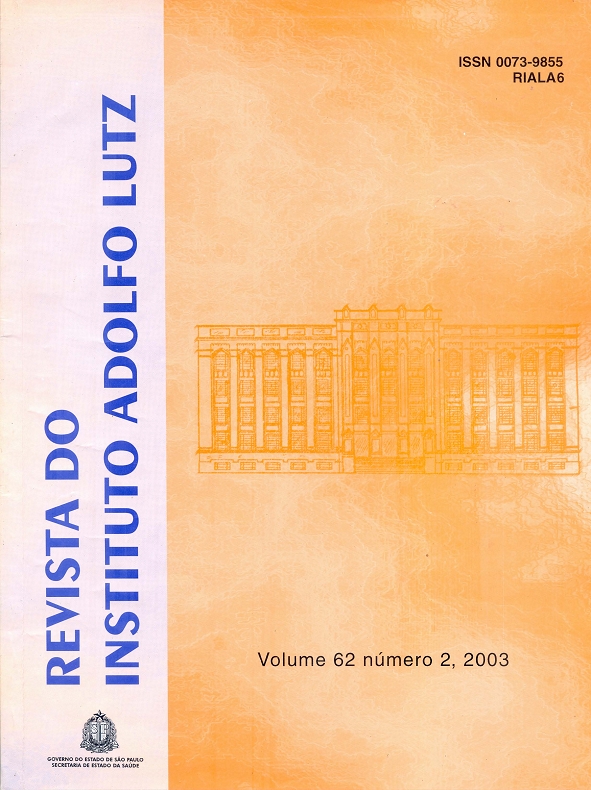Resumen
Os tricotecenos são um grupo de micotoxinas sesquiterpenóides produzidas por várias espécies de fungos, como Fusarium, Stachybotris, Trichothecium, Trichoderma e Myrothecium. Estes tricotecenos são relativamente estáveis aos principais processos e dificilmente são removidos dos grãos contaminados sob condições moderadas. O desoxinivalenol (DON) é o tricoteceno mais freqüentemente detectado. Outro é a toxina T-2, um tricoteceno do grupo A, freqüentemente encontrado em cereais, que tem sido bastante estudado por ser dez vezes mais tóxico que o DON. No presente trabalho, foi adaptado e avaliado um método para determinação simultânea da toxina T-2 e de DON por cromatografia de camada delgada (ccd). A matriz empregada para o desenvolvimento do procedimento foi o malte cervejeiro. Foram estudados sistemas de extração e purificação dos extrato, eluentes e agentes reveladores. Posteriormente o método foi aplicado em amostras de arroz e farinha de trigo. O limite de detecção do método foi de 40 ng/mancha para toxina T-2 e 50 ng/ mancha para DON; a recuperação média foi de 77,9% e 80,5%, respectivamente para cada toxina. Foram detectadas contaminadas uma amostra de arroz branco com 266µg. Kg-1 e duas de farinha de trigo com 128 e 323 µg. Kg-1 de DON.
Citas
1. Bata, A.; Ványi, A.; Lásztity, R. Rapid analytical method for the quantitative determination of trichothecene toxins in food and feeds. Acta Veter. Hungar., 32 (1-2): 51-56, 1984.
2. Bennett, G. A.; Shotwell, O.L. Criteria for determining purity of Fusarium mycotoxins. J. Assoc. Off. Anal. Chem., 73 (2): 270-5, 1990.
3. Betina, V. Thin layer chromatography of mycotoxins. J. Chromatogr., 334: 211-276, 1985.
4. De Nijs, M.; et al. Fungal infection and presence of deoxynivalenol and zearalenone in cereals grown in the Netherlands. J. Food Prot., .59(7): 772-7, 1996.
5. Furlong, E.B.; et al. Mycotoxins and fungi in wheat stored in elevators in the state of Rio Grande do Sul, Brazil.Food Add. Contam., 12(5):683-8, 1995.
6. Galvano, F.; et al. M. Activated carbons: in vitro affinity for ochratoxin a and deoxynivalenol and relation of adsorption ability to physicohemical parameters. J. Food Prot, 61(4): 469-75, 1998
7. Gimeno, A. Thin layer chromatographic determination of aflatoxins, ochratoxins, sterigmatocystin, zearalenone, citrinin, T-2 toxin, diacetoxyscirpenol, penicillic acid, patulin and penitrem a. J. Assoc. Off. Anal. Chem.,62(3): 579-85, 1979.
8. Kamimura H., et al. Y. Simultaneous detection of several fusarium mycotoxins in cereals, grains and foodstuffs. J. Assoc. Off. Anal. Chem. 64(5): 630-3, 1981.
9. Langseth, W.; Rundberget, T. Instrumental methods for determination of nonmacrocyclic trichothecenes in cereals, foodstuffs and cultures. J. Chromatogr. A, l.815: 103-21, 1998.
10. Marochi, M.A.; Soares, L.M.V.; Furlani, R.P.Z. Testes confirmatórios para tricotecenos. Rev. Inst. Adolfo Lutz, 56(2): 17-20, 1996.
12. Nunes, I. L. Micotoxinas, micoflora e seu potencial toxigênico em arroz destinado ao consumo humano. Rio Grande, RS, 2001, 95p [Dissertação de Mestrado, Programa de Pós-Graduação dm Engenharia e Ciência de Alimentos, FURG]
13. Romer, T.R. Use of small charcoal/alumina columns in determination of trichothecenes mycotoxins in foods and feeds. J. Assoc. Off. Anal. Chem. 69(4): 699-703, 1986.
14. Sabino, M.; et al. Determinação de deoxinivalenol em trigo e milho em grão por cromatografia em camada delgada. Rev. Inst. Adolfo Lutz, 49 (2): 155-9, 1989.
15. Schaafsma, A.W.; et al.. Analysis of fusarium toxins in maize and wheat using thin layer chromatography. Mycopathology, 142: 107-13, 1998.
16. Scott, P.M. Assessment of quantitative methods for determination of trichothecenes in grains and grains products. J. Assoc. Off Anal. Chem, 65(4): 876-882, 1982.
17. Scott, P. M. Determination of nivalenol, deoxynivalenol (vomitoxin), T-2 toxin, HT-2 toxin and diacetoxyscirpenol in cereals by gas chromatography with electron capture detection. In: Laboratory Procedures Of Health Protection Branch Laboratories – Bureau of Chemical Safety- Ottawa, August, 1986.
18. Scott, P.M. Trichothecenes in grains. Cereal Food World, 35(7): 661-6, 1990.
19. Soares, L. M. V. Micotoxinas: um método para análise simultânea e incidência em alimentos comercializados na região de Campinas, São Paulo. Campinas, SP, 1987.[Tese de Doutorado Universidade Estadual De Campinas, Faculdade De Engenharia De Alimentos].
20. Stahr, H.M.; et al.. Analysis of trichothecenes mycotoxins. Appl. Spectrosc., 37(4): 396-400, 1983.
21. Takeda, Y.; et al. Simultaneous extraction and fractionation and thin layer chromatographic determination of 14 mycotoxins. J. Assoc. Off. Anal. Chem., 62(3): 573-77, 1979.
22. Takitani, S.; Asabe, Y. Thin layer chromatographic analysis of trichothecenes mycotoxins. In: Y.Ueno Trichothecenes: Chemical, Biological And Toxicological Aspects. Kodasha. Ltda, Tokyo, Elsevier- Amsterdam, Oxford, New York,1983. IV p. 113-20.
23. Tanaka, T.; et al. Improved methodology for the simultaneous detection of the trichothecenes mycotoxins deoxynivalenol and nivalenol in cereals. Food Addit. Contam., 2(2): 125-7, 1985.
24. Tapia, M.O. A Quantitative thin layer chromatography method for the analysis of aflatoxins, ochratoxin a, zearalenone, T-2 toxin and sterigmatocystin in foodstuffs. Rev. Argent. Microbiol., 17(4): 183-6, 1985.
25. Trucksess, M., W.; Nesheim, S.; Eppley, R.M. Thin layer chromatographic determination of deoxynivalenol in wheat and corn. J. Assoc. Off. Anal. Chem. 67(1): 40-3, 1984.
26. Fonseca, H. Legislação Mundial para Micotoxinas. Http://www.micotoxinas.br, outubro de 2002.

Esta obra está bajo una licencia internacional Creative Commons Atribución 4.0.
Derechos de autor 2003 Edilira Baraj, Eliana Badiale-Furlong
